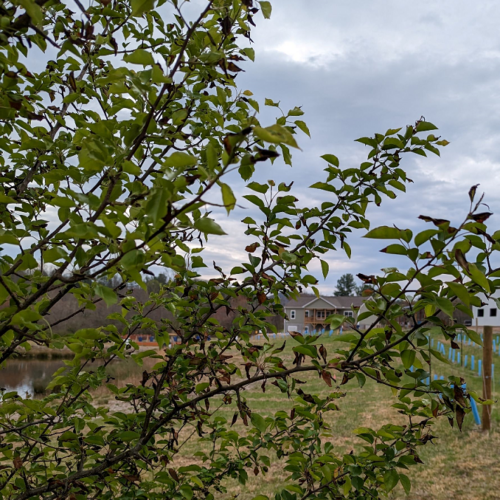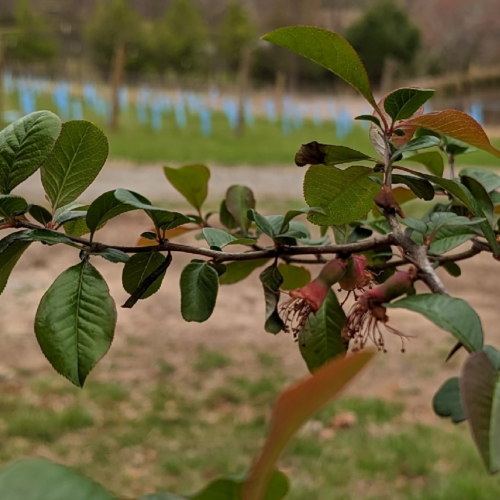Most microbes are beneficial and essential to life. The earth is replete with saprophytes (micro-organisms that decay organic matter) and symbiotic or mutualistic organisms (rhizobia, mycorrhizae) that are essential to plant establishment and health. Where would we be after all, in a world without mushrooms? And why rotate crops in a garden if legumes weren’t associated with nitrogen-fixing bacteria? But there are also the bad actors that suck the life out of plants! This last group incite disease. Disease may be defined by degree. For example, if leaf infections are limited, we refer them as “spots.” If they coalesce and infect more tissue, then it’s a “blotch,” but if covering the entire leaf and spreading into the woody tissues, we refer to them ignominiously as “blight.” These micro-organisms fall into four basic groups, which are bacteria, fungi, oomycetes, and phytoplasmas.
The bad actors, those that incite plant disease, include:
- Botrytis blight
- Black rot
- Black spot of roses
- Chestnut blight
- Downy mildew
- Fire blight
- Lethal bronzing of palms
- Oak wilt
- Phomopsis
- Powdery mildew
- Sycamore anthracnose
In this installment, we will discuss fire blight in the Rosaceae. Rosaceous plants susceptible to fire blight include:
- Apple (Malus )
- Brambles (Rubus )
- Chokecherry (Aronia)
- Cotoneaster (Cotoneaster)
- Firethorn (Pyracantha)
- Flowering Quince (Chaenomeles )
- Hawthorn (Crataegus )
- Juneberry (Amelanchier)
- Mountain Ash (Sorbus)
- Ninebark (Physocarpus)
- Pear (Pyrus )
- Photinia (Photinia)
- Quince (Cydonia)
- Rose (Rosa )
- Strawberry (Fragaria)
So, what is fire blight?
The term fire blight is descriptive of the symptoms expressed. Foliage appears burned, the tips droop into a “shepherds crook”, which is diagnostic. Symptoms appear in early spring. Infection progresses from flowers to twigs to stem. Infected woody tissues become cankered. Cankered tissues are at first water soaked, and later appear sunken. Canker infections result in dead bark tissue. Strip the bark away, and the sapwood appears streaked red-brown.
What causes fire blight? Fire blight is a bacterial infection incited by Erwinia amylovora.
How do plants become infected? In moist conditions, an amber-like ooze exudes from cankered tissues. The liquid contains the bacteria, and is spread by insects and rain splash. Plants are most susceptible at flowering. When bees visit the flowers, they can pick up the bacterium to spread it to other flowers. Infections are also spread by wind and rain. The nectaries are ideal for the growth of the bacteria since it is high in sugars, which act as a liquid growing medium.
What are the conditions that cause infection? Warm, humid temperatures favor infection, as does young, succulent tissues. Avoid over fertilization that results in succulent new growth, which is particularly susceptible to infection.
What is the impact of infection? The most obvious is killed leaf, fruit spur and woody tissues (i.e., blight). Infections occur in the fruiting spurs, infecting fruit and reducing fruit set. Uncontrolled, infections can spread to other plants.

How to control infections to keep plants healthy? Employing an integrated pest management (IPM) approach will help to keep plants healthy. These techniques include planting resistant varieties, employing cultural controls, and application of fungicides.
Cultural controls include pruning and fertilization practices. When applying fertilizer, shoot for moderate growth. Very high nitrogen applications will result in succulent growth that will exacerbate the incidence of infection. Consider slow-release products such as ArborPlex (14-4-5) which is formulated with 50% slow release (urea triazone) as the nitrogen source. Always follow label directions for use.
Do not severely prune trees which results in succulent growth. In late winter to early spring remove root suckers and water sprouts. Look for branch cankers. Prune and burn or dispose of infected tissues. Prune diseased tissues at least 12” below cankered tissues. When making pruning cuts, disinfect pruners between cuts using isopropyl alcohol or a 5% chlorine solution.
Make applications of copper-based fungicides. Use basic copper sulfate, copper soap or copper hydroxide formulations labeled for use. Note that copper may be phytotoxic to some apple cultivars. If you are not sure, spray a small leaf area, and observe whether there is any foliar damage 24 to 48 hours after treatment. If no visible damage is observed, make a spray application to the entire tree.

Join me next time when we talk about other issues that can occur – this time, concerning insects.
~ Signing off for now, Joe
